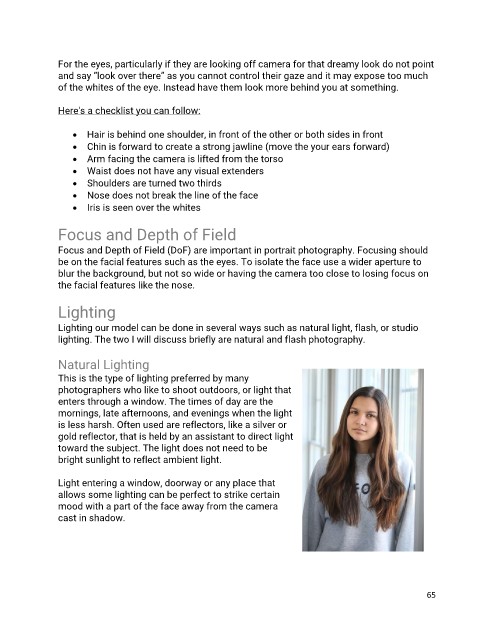Page 65 - Learning How to Photograph with your DSLR Camera 2nd Edition Jan 2021
P. 65
For the eyes, particularly if they are looking off camera for that dreamy look do not point
and say “look over there” as you cannot control their gaze and it may expose too much
of the whites of the eye. Instead have them look more behind you at something.
Here's a checklist you can follow:
• Hair is behind one shoulder, in front of the other or both sides in front
• Chin is forward to create a strong jawline (move the your ears forward)
• Arm facing the camera is lifted from the torso
• Waist does not have any visual extenders
• Shoulders are turned two thirds
• Nose does not break the line of the face
• Iris is seen over the whites
Focus and Depth of Field
Focus and Depth of Field (DoF) are important in portrait photography. Focusing should
be on the facial features such as the eyes. To isolate the face use a wider aperture to
blur the background, but not so wide or having the camera too close to losing focus on
the facial features like the nose.
Lighting
Lighting our model can be done in several ways such as natural light, flash, or studio
lighting. The two I will discuss briefly are natural and flash photography.
Natural Lighting
This is the type of lighting preferred by many
photographers who like to shoot outdoors, or light that
enters through a window. The times of day are the
mornings, late afternoons, and evenings when the light
is less harsh. Often used are reflectors, like a silver or
gold reflector, that is held by an assistant to direct light
toward the subject. The light does not need to be
bright sunlight to reflect ambient light.
Light entering a window, doorway or any place that
allows some lighting can be perfect to strike certain
mood with a part of the face away from the camera
cast in shadow.
65

